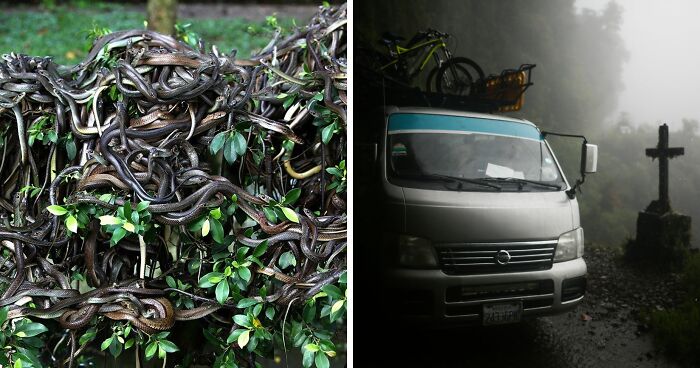
27-Year-Old Student Creates Solar Panels Made From Food Waste That Can Produce Energy Even On Cloudy Days
The James Dyson Award is an international design competition that runs in 27 countries, and it’s here to celebrate, encourage, and inspire the next generation of design engineers. The competition is open to university-level students in the fields of product design, industrial design, and engineering.
This year, the James Dyson sustainability prize landed in the hands of a 27-year-old Filipino student, Carvey Ehren Maigue, who found a genius way to turn food waste into energy.
More info: The James Dyson Award | Facebook | Instagram
Carvey Ehren Maigue is a 27-year-old Filipino student at Mapua University
Image credits: The James Dyson Award
Image credits: The James Dyson Award
Maigue’s creation that won him the sustainability prize is called AuREUS, and it’s a system that absorbs stray UV light from sunlight and converts it to clean renewable electricity—even when the weather is cloudy. And one of the best things about it all is that his solar panels are made out of fruit and vegetable waste.
This year, Maigue became the winner of the sustainability prize of the international James Dyson Award
Image credits: The James Dyson Award
Image credits: The James Dyson Award
Turns out, Maigue’s invention uses the natural scientific principles behind the northern lights. “1 Excess UV exposure in urban areas is being induced by glass buildings. The inspiration for the solution came from how auroras were made. High energy (gamma, UV) is degraded to a low-energy state (visible light) by luminescent particles in the atmosphere. The tech is based on this concept and used similar functioning particles,” the guy describes the inspiration behind his creation on the James Dyson Award webpage.
Maigue came up with a genius way to turn fruit and vegetable waste into energy
These new solar panels are made from fruit and vegetable waste and can be attached to windows and walls. “High-energy particles are absorbed by luminescent particles that re-emit them as visible light. Similar type of luminescent particles (derivable from certain fruits and vegetables) were suspended in a resin substrate and are used as the core technology,” Maigue explains the science behind his creation.
The invention is called AuREUS, and it’s a system that absorbs stray UV light from sunlight and converts it to clean renewable electricity
Image credits: The James Dyson Award
“When hit by UV light, the particles absorb and re-emit visible light along the edges due to internal reflectance. PV cells are placed along the edges to capture the visible light emitted. The captured visible light are then converted to DC electricity. Regulating circuits will process the voltage output to allow battery charging, storage, or direct utilization of electricity,” the guy explains.
The system continues to work even during cloudy weather
Image credits: The James Dyson Award
Image credits: The James Dyson Award
In other words, by using luminescent particles derived from fruit and vegetables, the AuREUS system allows high energy photons to be absorbed. And since it can pick up UV through clouds and bouncing from various surfaces, the system works even when the weather is cloudy.
And one of the best things about this system is that the solar panels are made out of food waste
Image credits: The James Dyson Award
Image credits: The James Dyson Award
“We can use AuREUS instead of typical glass windows so that the whole building can become a vertical solar energy farm. AuREUS can become a part of our clothes, our cars, buildings, and our houses. This is the change we can make for the future,” the guy adds.
Here’s what people are saying about this invention
32Kviews
Share on FacebookI'd like to use this when I move to Nova Scotia. Hopefully this product will be sold to the public some day!
None tracking solar panels become pretty much useless, for power generation at 47 degrees north or higher. So putting this on your windows in Nova Scotia, will be or poor financial decision. Getting propper solar panels, than track the sun, and some painted glass, will be cheaper and better in the long run.
Load More Replies...Where did I put that old shut up and take my money meme because it def applies here
I'd like to use this when I move to Nova Scotia. Hopefully this product will be sold to the public some day!
None tracking solar panels become pretty much useless, for power generation at 47 degrees north or higher. So putting this on your windows in Nova Scotia, will be or poor financial decision. Getting propper solar panels, than track the sun, and some painted glass, will be cheaper and better in the long run.
Load More Replies...Where did I put that old shut up and take my money meme because it def applies here

 Dark Mode
Dark Mode 

 No fees, cancel anytime
No fees, cancel anytime 

































































190
7